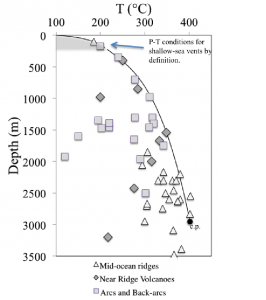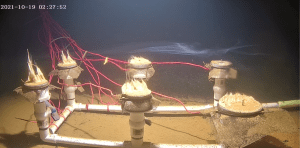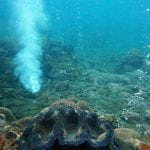
Roy Price
Current Positions
-Assistant Professor, School of Marine and Atmospheric Sciences (SoMAS), Stony Brook University, Stony Brook, New York, USA. Since September 2023.
-Affiliated Faculty, Department of Geosciences, Stony Brook University, Stony Brook, New York, USA.
Ph.D., 2008 University of South Florida, Tampa, FL.
roy.price@stonybrook.edu
CV
Google Scholar Profile
People
I am looking for students! I need one student, preferably a Ph.D. student, to conduct research on my NASA Habitable Worlds project “Habitability Estimates for Heterotrophic Metabolisms in Wet-to-Dry Transient Environments on Noachian Mars (HabMars)”. I’m also looking for at least one MSci and one Ph.D. student to work on Ocean Acidification monitoring offshore Long Island across the New York Bight. Please email me at roy.price@stonybrook.edu!!!
Click here for undergraduate and graduate student opportunities!
Dr. Roy Price is an aqueous geochemist who specializes in understanding two main themes: environmental hydrogeochemistry and hydrothermal vents, and the implications these have for life, both in the present and past, on Earth and beyond. He is also involved in a project focused on understanding long-term trends in carbonate chemistry and ocean acidification in the New York Bight (NYB), working with a team of Ecosystem and Climate Change Indicators experts to evaluate if and how OA might be affecting the biota associated with the NYB. He has numerous publications in diverse disciplines, ranging from nitrogen remediation in wastewater systems, arsenic biogeochemical cycling, bioenergetics of hydrothermal systems, contaminants of emerging concern, astrobiology and habitability of Mars.
Courses Taught, both graduate and undergraduate level:
Marine Pollution, Marine Microbial Ecology, Current Issues in Global Climate Change, Coastal Oceanography, Groundwater Hydrology / Principles and Applications of Groundwater Hydrology, Introduction to Physical Hydrogeology, Introduction to Oceanography. Introduction to Physical Geology.
News:
2025. Dr. Price received a SoMAS Minghua Jiang Seed grant for the project “The fate of organic pollutants being discharged through ocean outfalls to the New York Bight”; as PI.
2025. New York State Department of Environmental Conservation project funded: Studies of Nearfield Impacts of Ocean Outfalls; as PI.
2024. New York State Department of Environmental Conservation project funded: Development and implementation of an ocean ecosystem monitoring program for New York Bight, as Co-I.
2023. The Price laboratory awarded the NASA Habitable Worlds grant “Habitability Estimates for Heterotrophic Metabolisms in Wet-to-Dry Transient Environments on Noachian Mars (HabMars)”
MEDIA: Dr. Price and the team connected with the NASA Habitable Worlds proposal “Habitability of saponite-rich hydrothermal systems on early Mars” grant was featured in a recent documentary with the German national television network “ZDF”, the most viewed television channel in Germany. It aired in Germany in the program Wunder der Natur: Islands Vulkane, which means Wonder of Nature: Iceland’s Volcanoes. Of this, 8 minutes were dedicated to the NASA project. The entire program was also available in an English version, and those 8 minutes can be viewed here!
GRANT!! The Price lab has just been funded by NASA Habitable Worlds program for the project “HabMars: Habitability estimates for heterotrophic metabolisms in wet-to-dry transient environments on Noachian Mars (HabMars)”! Click HabMars 2023 summary for more information. This project will fund one full Ph.D. dissertation and one M.Sci. thesis at Stony Brook University, and will focus on the bioenergetics -and thus habitability- of organic compounds found in Icelandic lakes. These lakes, which often include hydrothermal vents, are our best Earth-analogues for Noachian Martian lake environments. Please reach out to Dr. Price for more information! The student can matriculate through the SoMAS or SBU Geosciences graduate schools.

Dr. Price has been selected as a 2022-23 Hanse-Wissenschaftskolleg (HWK) fellow!! This highly prestigious fellowship is located in Delmenhorst, Germany at the Institute for Advanced Study. It promotes excellent science through fellowships for scientists, artists and authors from all over the world, as well as through scientific events. More here!
Consider submitting an abstract to our session for AbSciCon 2022 titled “Geochemistry and Habitability of Alkaline Hydrothermal Vents on Earth and Beyond”. The abstract submission deadline is January 19, and the conference will be held from May 15-20, 2022. We are very pleased to announce that Dr. Alexis Templeton from UC Boulder and Dr. Deborah Kelly from the University of Washington will be our invited speakers in the oral session. Please reach out to us if you have any questions, and feel free to share this with folks you think may be interested in participating, as well. Thank you for your time, and we hope to see you at AbSciCon 2022!
![]()
Our artificial hydrothermal vent chimney growth experiments! Please check back for more updates soon!
Congratulations to Arlaine Sanchez for her New Publication “Exploring habitability using artificial hydrothermal vents“, just published in Nature Reviews Earth and Environment “tools of the trade”. Way to go Arlaine!!
New Publication! Nitrogen transformations in constructed wetlands: A closer look at plant-soil interactions using chemical imaging. S Nyer, N Volkenborn, R Aller, M Graffan, Q Zhu, and RE Price. Science of the Total Environment, 2021.
New Publication! Spatial variation of subduction zone fluids during progressive subduction: Insights from Serpentinite Mud Volcanoes
C Menzies, RE Price, J Ryan, O Sissmann, K Takai… – Geochimica et Cosmochimica Acta, 2021
New Publication! Occurrence and Removal of PPCPs from On-site Wastewater Using Nitrogen Removing Biofilters
PM Clyde, CS Lee, RE Price, AK Venkatesan… – Water Research, 2021
New Publication! The chemistry of hyperalkaline springs in serpentinizing environments: 1. the composition of free gases in New Caledonia compared to other springs worldwide
C Monnin, M Quéméneur, R Price, J Jeanpert, P Maurizot, C Boulart, …
Journal of Geophysical Research: Biogeosciences 126 (9), e2021JG006243 2021
Dr. Price has been invited to present at the prestigious Gordon Research Conference on the Origin of Life, in the session “Hydrothermal Vents: Differences Between Modern and Hadean Earth”. The title of his presentation is “Extending the submarine alkaline vent model for life’s emergence to the shallow sea.” The conference will be in person Janurary 23-28, 2022 in Galveston, Texas.
Strytan 2021 was a success! Roy Price, along with SBU students Holly Rucker (M.S.) and Arlaine Sanchez (Ph.D.), and with Dr. Laurie Barge from Jet Propulsion Laboratory and Dr. Donato Giovannelli from the University of Naples, recently traveled to sample the Strytan Hydrothermal System in Eyjafjord, northern Iceland. This is part of our ongoing efforts to better understand Habitability of early Martian alkaline hydrothermal systems in the Eridania Basin. Thank you to the NASA Habitable Worlds program for funding this research!!
Congratulations to Holly Rucker for completing her MS degree, “Habitability of Eridania Lake: The Bioenergetics of an Ancient Mars Lacustrine Hydrothermal Vent compared to an Icelandic Analogue Fjord Site”. This research has impactful implications for habitability of early Martian alkaline hydrothermal vents and illustrates the limits of using Earth-based hydrothermal systems as analogs.
New Publication! A Khimasia, CE Renshaw, RE Price, T Pichler. 2021. Hydrothermal flux and porewater geochemistry in Paleochori Bay, Milos, Greece. Chemical Geology.
New Publication! H Roberts, R Price, CC Brombach, T Pichler. 2021. Mercury in the hydrothermal fluids and gases in Paleochori Bay, Milos, Greece. Marine Chemistry, 103984
SBU SoMAS MS student Holly Rucker presented her research “Habitability of Eridania Lake: An Ancient Mars Lacustrine Hydrothermal Vent, Compared to an Icelandic Analogue Fjord Site” to the 2021 Lunar and Planetary Science Conference! Way to Go Holly!!
New Publication! Gobler et al. 2021. Removing 80%–90% of nitrogen and organic contaminants with three distinct passive, lignocellulose-based on-site septic systems receiving municipal and residential wastewater. Ecological Engineering 161, 106157
The Price Lab had four publications and one conference presentation in 2020! Publications include Jones et al in Astrobiology (3D Printed Minerals as Astrobiology Analogs of Hydrothermal Vent Chimneys), Lu et al. in PloS One (Bioenergetic characterization of a shallow-sea hydrothermal vent system: Milos Island, Greece), Wehrmann et al. in JSWBE (Biogeochemical Sequestration of Phosphorus in a Two-Layer Lignocellulose-Based Soil Treatment System), and finally Fryer et al. in Philosophical Transactions of the Royal Society A (Mariana serpentinite mud volcanism exhumes subducted seamount materials: implications for the origin of life). Yang Gao and Greg Henkes (SBU Geosciences) worked with the Price lab to produce the first ever “Clumped isotope geochemistry of carbonates formed in association with shallow water continental methane seeps at Prony Bay, New Caledonia and Elba, Italy“. Yang presented this work at the AGU Fall Meeting.
OUTREACH: Dr. Price presents ‘Measuring the Geochemistry of Hydrothermal Vents’ for the InVADER Mission using “Learning Glass,” a new technology that allows presenters to write notes while maintaining face-to-face contact with students, using a transparent whiteboard and technology that reverses the writing so the students can also read what is written. The video can be viewed on the InVADER website.
Price lab just funded from the NASA Habitable Worlds program! The title of the project is “Habitability of saponite-rich hydrothermal systems of early Mars.” Funding is now available for a graduate student to join the lab on this project. Please contact Dr. Price for more information.
Roy Price’s photograph of alkaline shallow-sea hydrothermal vents featured on the cover of this month’s issue of The Royal Society’s “Interface Focus” (vol 9, no 6) journal in a special theme issue ‘The origin of life: the submarine alkaline vent theory at 30’ organised by Julyan Cartwright and Michael Russell. The cover photo caption reads “Photograph of submarine chimneys comprising carbonates and brucite (Mg[OH]2) precipitating from alkaline hydrothermal fluids, Prony Bay, off New Caledonia, kindly contributed by Roy Price (cf. Price et al. Geology 2017:45(12),1135). Comparable chimneys in the Hadean would have comprised the iron oxyhydoxide, fougerite (~Fe2[OH]5) (Russell, Geology (2017) 45 (12): 1143-1144.)”
Using CO2-rich shallow-sea vents as analogs to investigate the influence of ocean acidification on coral reefs in Papua New Guinea
Roy Price participates in expedition to investigate the influence of ocean acidification on coral reefs in Papua New Guinea using CO2-rich shallow-sea vents as analogs. Project video available on YouTube.
Price lab publishes on arsenic nano-particle characterization and fluxes from shallow-sea hydrothermal vents, with implications for coastal marine ecosystems and global hydrothermal fluxes of arsenic.
Price lab funded through part of NASA PSTAR: “InVADER: In-situ Vent Analysis Divebot for Exobiology Research”, for “Furthering the understanding and exploration readiness of terrestrial and planetary underwater vent systems”. See project description here. This project focuses on analysis of hydrothermal vent fluid and precipitate samples collected from the Axial Seamount on the Juan de Fuca Ridge, in support of the InVADER objectives.
The Price lab is looking for undergraduate student volunteers who are interested in assisting with cultivation of arsenotrophs – microbes who oxidize or reduce arsenic for energy and growth. Samples are in hand and ready for inoculation. Please contact Dr. Price if interested.
My research focuses on element cycling in the hydrological cycle, including:
- Geochemical evolution of hydrothermal vent fluids, particularly shallow-sea vents.
- Cycling of toxic elements in coastal marine environments, either naturally occurring or anthropogenic.
- Environmental geochemistry, emphasizing source, fate, flux, transport and bioaccumulation of toxins.
- Mobilization mechanisms and fate of arsenic in groundwater aquifers.
- Abiotic vs. biotic (microbial) processes across redox gradients.
- Shallow-sea analogs for early-Earth conditions and the origin of life.
Recent presentations:
Detailed Research Interests
 My research interests generally focus on element cycling in the hydrological cycle. As such, I am interested in a wide range of topics. However, my primary focus is on the geochemical evolution of hydrothermal vent fluids, particularly for shallow-sea vents, and the consequences this has for toxic metal cycling, bioaccumulation and microbial communities in these important coastal environments.
My research interests generally focus on element cycling in the hydrological cycle. As such, I am interested in a wide range of topics. However, my primary focus is on the geochemical evolution of hydrothermal vent fluids, particularly for shallow-sea vents, and the consequences this has for toxic metal cycling, bioaccumulation and microbial communities in these important coastal environments.
Shallow-sea hydrothermal vents are generally defined as occurring at a water depth < 200 m, a depth which marks the deepest extent of the photic zone and coincides with a large change in the slope of the seawater boiling curve. Their easy accessibility, relative to deep-sea hydrothermal systems, makes them excellent natural laboratories to study a wide range of chemical, physical, and biological processes. I’ve undertaken several research projects related to these types of hydrothermal vents. Click the link to see a brief description:
- Panarea Island (Italy)
- Milos Island (Greece)
- Prony Bay (New Caledonia)
- Eyjafjord (Iceland)
- Ambitle Island (Papua New Guinea)
- Dominica Island (Caribbean)
My research is not limited to hydrothermal vent research. I’ve also worked on several projects focused on understanding arsenic cycling in southwest Florida. Click here to learn more.
Dr. Price’s Twitter Feed:
July News and Research Updates
Photo above: Kevin Reed discusses the impact of climate change on extreme weather events on “Doug To The Rescue.” Here’s the latest news and press from SoMAS for July! Congratulations to SoMAS PhD student Arlaine Sanchez for her “Tools of the Trade” article about…
Winter Faculty Research News
Photo above: Dr. Flagg’s latest flight over the breach at Old Inlet Here are the latest updates about our faculty and their research. Dr. Hyemi Kim’s recent publication “Insignificant QBO‐MJO prediction skill relationship in the SubX and S2S subseasonal reforecasts”…
New Faculty Research Awards
Congratulations to our faculty for their recent research awards!Gordon Taylor received a new NSF award, in the amount $514,960, in support of the project “Collaborative Research: Key Microbial Processes in Oxygen Minimum Zones: From in Situ Community Rate Measurements…
SoMAS Convocation 2018
Congratulations to our graduates! The annual SoMAS Convocation occurred on Friday, May 18, 2018 at the Student Activities Center auditorium. Students gathered with their friends and family and SoMAS faculty and staff to celebrate the completion of their journey at…
Ambitle Island (Papua New Guinea)
Principle Investigator: Roy Price See these publications: Distribution, speciation and bioavailability of arsenic in a shallow-water submarine hydrothermal system, Tutum Bay, Ambitle Island, PNG Shallow-water hydrothermal vent systems can introduce large amounts of…
The Strytan Hydrothermal Field (SHF), Eyjafjord, Iceland
Principle Investigator: Roy Price The Strytan Hydrothermal Field (SHF) is located in Eyjafjord, northern Iceland, exhibits off-axis, alkaline (pH ~ 10), hot (up to 78°C), submarine hydrothermal venting, building a 55 meter high saponite tower. In the context of…
Milos Island, Greece
Principle Investigator: Roy Price Arsenic (As) is naturally enriched in most terrestrial and marine hydrothermal systems. Its discharge from shallow-sea hydrothermal vents into coastal marine environments can dramatically affect the surrounding ecosystems….
Panarea Island, Italy
Principle Investigator: Roy Price At the shallow-sea vents off Panarea Island (Italy), hydrothermal venting is manifested as abundant gas and fluid discharge. Vent fluids, pore fluids and gases at three sites were sampled and analyzed for major and minor elements,…
Shallow-sea Hydrothermal Vents
Principle Investigator: Roy Price The subsurface geochemical processes controlling the composition of discharging hydrothermal fluids are a function of many factors including fluid-mineral equilibria, phase separation, magmatic inputs, mineral precipitation, and…

